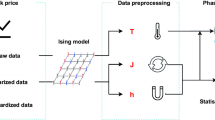Abstract
The use of data compressor techniques has allowed to recognize magnetic transitions and their associated critical temperatures [E.E. Vogel, G. Saravia, V. Cortez, Physica A 391, 1591 (2012)]. In the present paper we introduce some new concepts associated to data recognition and extend the use of these techniques to econophysics to explore the variations of stock market indicators showing that information theory can help to recognize different regimes. Modifications and further developments to previously introduced data compressor wlzip are introduced yielding two measurements. Additionally, we introduce an algorithm that allows to tune the number of significant digits over which the data compression is due to act complementing, this with an appropriate method to round off the truncation. The application is done to IPSA, the main indicator of the Chilean Stock Market during the year 2010 due to availability of quality data and also to consider a rare effect: the earthquake of the 27th of February on that year which is as of now the sixth strongest earthquake ever recorded by instruments (8.8 Richter scale) according to United States Geological Survey. Along the year 2010 different regimes are recognized. Calm days show larger compression than agitated days allowing for classification and recognition. Then the focus turns onto selected days showing that it is possible to recognize different regimes with the data of the last hour (60 entries) allowing to determine actions in a safer way. The “day of the week” effect is weakly present but “the hour of the day” effect is clearly present; its causes and implications are discussed. This effect also establishes the influence of Asian, European and American stock markets over the smaller Chilean Stock Market. Then dynamical studies are conducted intended to search a system that can help to realize in real time about sudden variations of the market; it is found that information theory can be really helpful in this respect.
Similar content being viewed by others
References
E.E. Vogel, G. Saravia, F. Bachmann, B. Fierro, J. Fischer, Physica A 388, 4075 (2009)
E.E. Vogel, G. Saravia, V. Cortez, Physica A 391, 1591 (2012)
V. Cortez, E.E. Vogel, G. Saravia, submitted to J. Magn. Magn. Mat. (2014)
K. Binder, D.W. Heermann, Monte Carlo Simulation in Statistical Physics, 4th edn. (Springer-Verlag, Berlin, Heidelberg, 2002)
D.G. Luenberger, Information Science (Princeton University Press, Princeton, Oxford, 2006)
T.M. Cover, J.A. Thomas, Elements of Information Theory, 2nd edn. (John Wiley & Sons, New York, 2006)
J.G. Roederer, Information and its role in Nature (Springer, Heidelberg, 2005)
V. Filimonov, D. Sornette, Phys. Rev. E 85, 056108 (2012)
G. Drogalas, S. Athianos, G. Bakas, G. Elekidis, in Proceedings of the 7th Annual MIBES International Conference, 8-10 June 2013, Larissa, Greece, pp. 579–593
R. Romero-Meza, C.A. Bonilla, M.J. Hinich, Appl. Econ. Lett. 14, 987 (2007)
H. Berument, H. Kiymazm, J. Econ. Finance 25, 181 (2001)
H. Kiymaz, H. Berument, Rev. Finance Econ. 12, 363 (2003)
D. Kenourgios, A. Samitas, Int. Res. J. Finance Econ. 15, 78 (2008)
L.A. Gil-Alana, J. Cunado, F. Perez de Gracia, Physica A 392, 3198 (2013)
H. Entorf, A. Gross, C. Steiner, J. Forecasting 31, 1 (2012)
E.E. Vogel, G. Saravia, submitted to Physica A (2014)
O.M. Landerretche, C. Martıinez, J. Pension Economics Finance 12, 251 (2013)
Author information
Authors and Affiliations
Corresponding author
Rights and permissions
About this article
Cite this article
Vogel, E.E., Saravia, G. Information theory applied to econophysics: stock market behaviors. Eur. Phys. J. B 87, 177 (2014). https://doi.org/10.1140/epjb/e2014-41003-0
Received:
Revised:
Published:
DOI: https://doi.org/10.1140/epjb/e2014-41003-0




